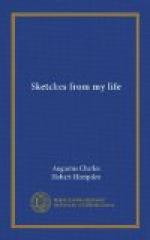I understand that in India or in Africa, where there are hundreds of different sorts of deer, the real fallow is not to be found. While shooting at a place called Camaris, near to Gallipoli, two years since, I discovered several herds of these deer, beautiful creatures, wild as hawks, and accordingly laid myself out to shoot some of them if possible. I tried driving, stalking, and every manoeuvre to circumvent them, without success. At last one day I started with my beaters to a place where there were many tracks of fallow deer. I was posted at a sort of small mountain pen, having on one side of me a young friend of mine, and at the other a native (these fellows won’t go out unless they are allowed to carry their guns).
Shortly after the beaters had begun to halloo, a fallow hind glided by between me and my young friend, like a ghost. Not a sound in the wood gave notice of its approach. It was even quieter in its movements than a hare would have been. I put up my gun to fire, but seeing my friend’s head right in the way and in a line with its muzzle, I waited a second, but the deer was gone. I had scarcely got over my disappointment when I heard the branches breaking in the wood very near to me, and suddenly a deer sprang right over my head, taking a flying leap, like a hunter would do over a fence.
This unusual action on the part of the deer called for unusual action on my part. As he had taken a flying leap over my head, I took a flying shot at him a second before he landed on the other side of me. The result was that he rolled over like a rabbit, shot from underneath through the heart. This deer proved to be a very fine specimen of the fallow, every point showing him to be of that species, except his antlers, which were quite straight. This I cannot account for; the natives, who had remarked this deer on several occasions feeding with the herd of fallow deer, called it the ‘Cassic Boa,’ which means ‘straight-horned.’ Some time after this I had some good sport with the fallow deer. Having got more accustomed to their habits, I found that it was of no use trying to approach them, their scent being too keen, their eyesight too sharp; the only way to get them is by very careful, in fact I may say scientific, driving.
Good boar shooting may be had by going some little distance from Constantinople. It usually is done either by beaters or with boarhounds; but I have had very good sport at boar while hunting for woodcocks and pheasants, in what may be called covert shooting—not exactly English covert shooting, in which almost every tree is known by the keepers, but in coverts of great extent, in which there are almost impassable thickets, made still more impassable by a well-known bramble called the ‘wait a bit,’ a thing that hooks on to your eyelids as you pass.
There it is that in these coverts spaniels, half-English, half country-bred dogs, do frequently the work of beaters, and it is a strange fact that while piggy starts at once from his lair at the approach of the boarhounds, he will not budge an inch for the little yapping spaniel, whom he treats with contempt.




